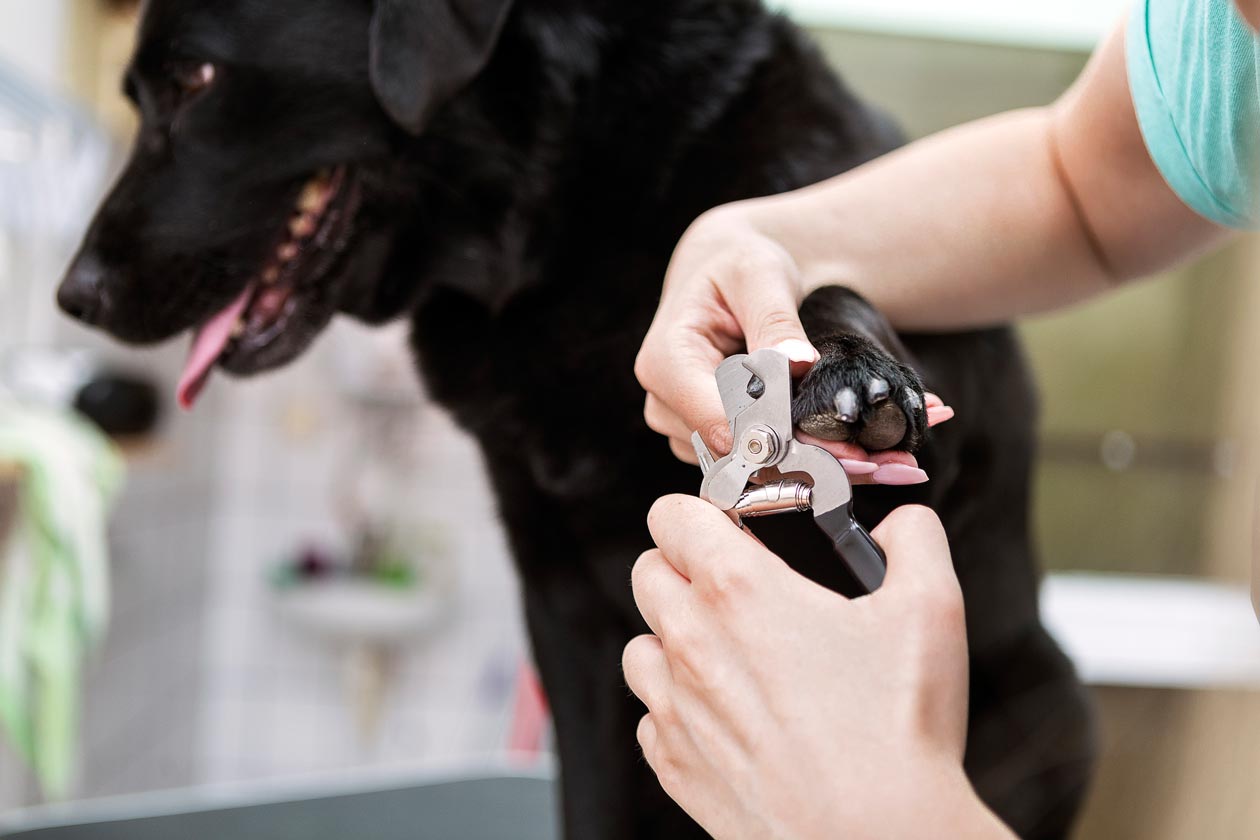How to Get Your Dog to Cooperate: Common Care Issues

Even if your dog is a well-behaved canine companion most of the time, there are likely some care issues he doesn't like to go along with. Here, we'll talk about some of those and give you tips for improving your dog's compliance.
Nail Trims
If your dog doesn't like having her nails trimmed, she's not alone. Many dogs dislike having their paws manipulated, and nail trims may be especially tricky. However, regular trimmings help keep your furniture, floors, and skin safe from accidental scratches and decrease the chance that your dog will suffer from a torn nail or other claw-related injuries.
Note: We use the word nails here because it's used commonly, but dogs actually have claws. Check it out: "Claws vs. Nails: What Do Dogs Have?"
Start as early as possible getting your dog used to nail trims. If you get a new puppy, begin on the first day you have her by playing with her feet and toes often, so she gets used to having them handled.
When you begin trimming your dog's nails, be sure to use care to decrease the chances that you'll nick the blood vessel, which is painful and may cause your dog to be more uncooperative about trims in the future. Try to trim off just the curved tip of the nail once a week or so. That way, the nails won't get so long that you'll feel the need to trim them back far, risking a cut to the quick.
When you first start getting your dog used to nail trims, you might only get to do one or two at a time. That's fine. It's better to have slow, steady, positive progress than to risk your dog having a negative experience.
Get a second person to help you when you're trimming your dog's nails. That person can keep your dog steady, hold up the paw, or just pet, praise, and give treats to the dog while you do the trimming.
Always stay calm while you're getting your dog used to nail trims. Use a soft, confident voice, and always reward good behavior, no matter how small. If you're calm, your dog will be less likely to get upset.
Learn more here: "Helpful Tips for Trimming Your Dog's Nails."
Ear Cleanings
Not all dogs need routine ear cleanings, but some do. If your veterinarian recommends it, you should get into the habit of doing it because it may decrease the incidence of painful ear infections. Also, ear cleanings are beneficial after baths or swims because an ear cleaner that contains a drying agent can reduce the risk of ear infection after water gets in the ear canal.
However, many dogs dislike having their ears messed with. This is another area of the body that you should focus on if you have a puppy—get her used to having her ears handled by petting them, lifting the flaps if she has them, looking and sniffing inside, and softly touching the skin at the outer part of the ear canal.
When it's time to clean your dog's ears, a helper is a great idea. Have someone hold your dog and keep her steady. If you can, do the cleaning outside or at least in an easy-to-clean area because your dog will shake her head, and ear cleaner and debris will spray out.
It can really help to have the staff at your veterinary clinic give you a demo on how to clean your dog's ears.
Again, stay calm as you clean your dog's ears, and give praise and treats to help things along. Gently lift your dog's ear flap, put a little cleaner in, close the flap, and rub the outside of the ear to get the cleaner deep down into the canal. Dogs usually like that part, so try to get to it as quickly as possible. Then, allow your dog to shake her head and finish by using cotton balls to wipe out any debris and ear cleaner you can see at the ear canal's opening.
Learn more: "How to Clean a Dog's Ears."
Baths
While many dogs like water, baths can be another issue. Often, they don't like to sit still while you wet them, shampoo them, rinse them, and dry their fur.
Luckily, most dogs don't need baths too often. In fact, over-bathing can cause skin problems. But there will be times when your dog does need a bath, either because she's stinky or due to a skin condition. Learn more: "Should I Bathe My Dog Regularly?"
If your dog is afraid of having a bath, go slowly, stay calm, and give lots of praise and treats. Start with just a tiny amount of water in the tub, and put a toy in there, so your dog gets interested.
Some dogs do better when water is poured onto them than when they are sprayed, so try filling some containers with warm water and using those instead of a hose or sprayer. Also, if your dog doesn't like baths, you might wish to avoid doing her head and face if you can. That might help her tolerate it better, and you can work up to doing her face and head later.
Learn more: "How to Give a Dog a Bath."
Taking Oral Medication
Most dogs will need to take some kind of oral medication at some point in their lives, and it can sometimes be tricky to get it into them.
If the medication is a pill, you might get away with hiding it in a piece of food or peanut butter. Just be extra sure your peanut butter doesn't contain xylitol, which is extremely toxic to dogs.
You can try a product like Pill Pockets to give your dog tablets, as long as she is allowed to have flavored treats. They have space into which you can put the medicine and then pinch the soft treat closed around it, hiding it from your dog.
Liquid medication can be trickier. You must use a syringe, tip your dog's nose toward the ceiling, and put the tip of the syringe in the back corner of the mouth. The syringe needs to get between your dog's teeth, and then you'll have to empty it slowly into the back of the dog's mouth, trickling it in, so she has time to swallow. You may be able to hide liquid medication in a small amount of canned dog food, but ask your vet to be sure. And you'll have to watch that your dog eats it all, which can be tricky if she smells the medicine and refuses.
Tooth Brushing
Many dogs have some degree of dental disease by the time they are two or three years old. That's a problem because it's painful and can contribute to other illnesses which may shorten a dog's life. Proper dental care is critical for a dog's continuing good health and comfort.
Routine professional dental cleanings at a veterinary clinic, while the dog is under anesthesia, are crucial to keeping teeth clean and identifying and treating any problems that come up. But, alone, that isn't enough. Home dental care is also necessary. Brushing your dog's teeth daily with enzymatic toothpaste can dramatically reduce her dental disease and perhaps prolong her life.
Many dogs dislike having their teeth brushed because they aren't used to having their mouths messed with. So, as is the case with nails and ears, you should begin acclimating your dog to tooth brushing by using your fingers to lift her lips, massage her mouth, and eventually, touch her gums and teeth. Once she's amenable to that, let her get used to a soft children's toothbrush or finger brush with some canine toothpaste on it. Don't use human toothpaste, which may contain toxic-to-dog ingredients like xylitol and surfactants that may cause vomiting.
Your goal for a tooth-brushing session, ultimately, is to smear enzymatic toothpaste on all the outward-facing surfaces of all your dog's teeth. This should take one to two minutes each time. Use praise, a calm voice, and treats to make it enjoyable for your dog.
Remember, getting your dog to cooperate for disliked care events takes time, training, patience, and positivity.
You May Also Like These Articles:
Otitis Externa: Ear Infections in Dogs
Helpful Tips for Trimming Your Dog's Nails
Disclaimer: This website is not intended to replace professional consultation, diagnosis, or treatment by a licensed veterinarian. If you require any veterinary related advice, contact your veterinarian promptly. Information at DogHealth.com is exclusively of a general reference nature. Do not disregard veterinary advice or delay treatment as a result of accessing information at this site. Just Answer is an external service not affiliated with DogHealth.com.
Notice: Ask-a-Vet is an affiliated service for those who wish to speak with a veterinary professional about their pet's specific condition. Initially, a bot will ask questions to determine the general nature of your concern. Then, you will be transferred to a human. There is a charge for the service if you choose to connect to a veterinarian. Ask-a-Vet is not manned by the staff or owners of DogHealth.com, and the advice given should not delay or replace a visit to your veterinarian.



